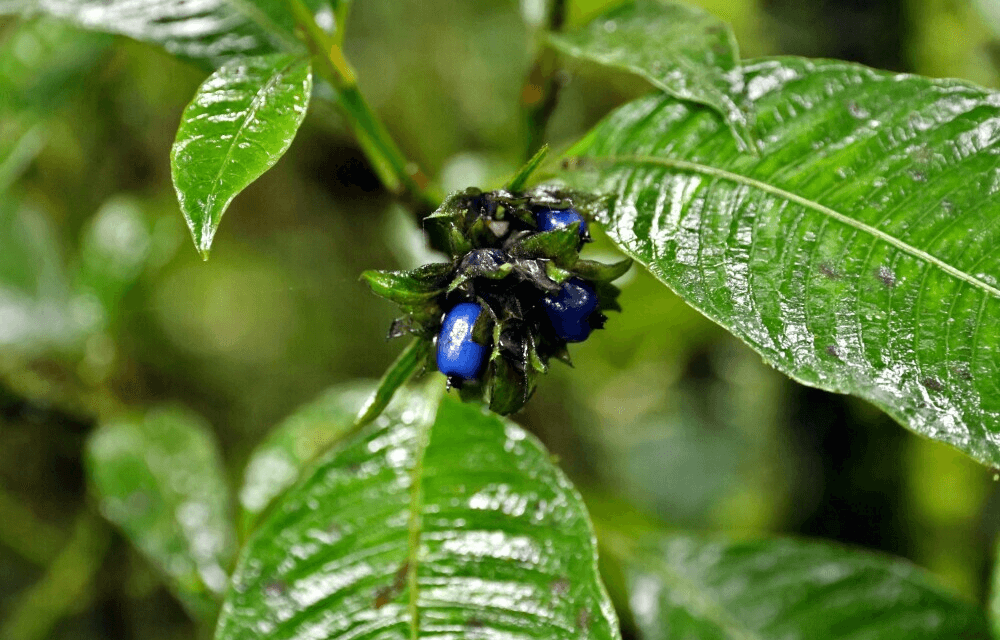Imagine a world painted in a myriad of blue shades, reminiscent of the azure sky and the sapphire ocean depths. Now, picture this vivid blue hue gracing your fruit bowl, where each fruit not only captivates the eye but also offers remarkable health advantages. Among them, “The Best Blue Fruit For Diabetics” stands out, promising not just visual delight but also potential benefits for those managing their health.
For those managing diabetes, incorporating certain fruits into your diet can significantly make a difference in maintaining balanced sugar levels. Amongst this rainbow of nutritious options, one color stands out – Blue! Intriguing right? Sit back as we take you through the list of blue fruits and their potential power against diabetes.
30 Blue Color Fruits Diabetics Could Consider
Blue-colored fruits, renowned for their captivating hues, offer various health benefits, thanks to their rich antioxidant content.
1. Blueberries
Blueberries are prized for their sweet-tart flavor and deep blue hue; they offer nutrient-rich benefits and versatility in culinary applications.
2. Blue Grapes
With their crisp texture and subtly sweetness, blue grapes are perfect for snacking or or enhancing salads and cheese platters..
3. Blue Plums
Blue plums, well-known for their vibrant hue and sweet-tart flavor, feature juicy flesh, ideal for jams, sauces, and baked goods.
4. Elderberries
Rich in immune-boosting antioxidants, elderberries offer a tangy-sweet flavor that shines in jams, syrups, and herbal teas.
5. Black Currants
These dark blue berries are rich in vitamin C, boasting a bold, slightly tart flavor, ideal for juices, jams, and desserts.
6. Huckleberries
Native to North America, huckleberries are prized for their intense flavor reminiscent of blueberries, perfect for pies, pancakes, and preserves.
7. Blue Passionfruit
This unusual fruit features a blue outer shell with juicy, aromatic seeds inside, offering a tropical burst of flavor with hints of tartness and sweetness.
8. Blue Pluots
A cross between plums and apricots, blue pluots combine the best of both worlds, with a luscious texture and a balanced flavor profile.
9. Saskatoon Berries
Also known as serviceberries, these blue-purple fruits have a sweet, nutty taste and are commonly used in pies, muffins, and jams.
10. Blue Peaches
With their unique blue skin and juicy, sweet flesh, blue peaches make a stunning addition to fruit salads and desserts.
11. Blue Apples
Less common than other blue fruits, certain apple varieties develop a bluish skin, enhancing visual appeal in fruit baskets and recipes.
12. Blue Figs
Figs with a deep blue-purple color are not only visually striking but also boast a rich, honeyed flavor that pairs beautifully with cheese or honey.
13. Juniper Berries
Though technically not a fruit, juniper berries are used as a spice in cooking and gin production, imparting a distinctively piney, citrusy flavor to dishes.
14. Blue Tomatoes
These heirloom tomatoes feature a striking indigo hue and a rich, complex flavor profile that adds depth to salads and sandwiches.
15. Blue Corn
Primarily used for making masa flour and tortillas, but can also be ground for baking or enjoyed as crunchy chips.
16. Blue Potatoes
With their vibrant blue-purple flesh, these potatoes add a pop of color to any dish and offer a slightly nutty flavor when roasted or mashed.
17. Acai Berries
Hailing from the Amazon rainforest, acai berries are celebrated for their antioxidant-rich properties and deliciously tart flavor, often enjoyed in smoothie bowls or as a topping for yogurt.
18. Blue Spirulina
Derived from blue-green algae, blue spirulina is prized for its vibrant color and nutrient density, making it a popular addition to smoothies, juices, and desserts.
19. Blue Prickly Pear
The fruit of the prickly pear cactus, these bluish-purple orbs are sweet and refreshing, with a flavor reminiscent of watermelon and berries.
20. Blue Java Banana
Also known as the “ice cream banana,” this tropical fruit features a blue-green peel and a creamy texture, making it a delightful treat when frozen or blended into smoothies.
21. Blue Muntingia
Blue muntingia berries are small but packed with flavor, offering a sweet-tart taste that pairs well with other fruits in jams and preserves.
22. Blue Chokeberries
These tart berries are prized for their high antioxidant content and are often used in jams, sauces, and baked goods to add a tangy kick.
23. Blue Starfruit
With its distinctive star-shaped slices and tangy-sweet flavor, blue starfruit is a visually stunning addition to fruit salads and cocktails.
24. Blue Pears
Unlike other common varieties, some pears varieties develop a bluish tint on their skin, enhancing fruit presentations and dessert aesthetics.
25. Blue Jackfruit
Known for its large size and fibrous texture, blue jackfruit offers a mild, sweet flavor that pairs well with savory dishes or can be enjoyed on its own.
26. Blue Mangoes
Mangoes with blue-purple skin provide a unique twist, featuring sweet, juicy flesh ideal for snacking or blending into smoothies.
27. Blue Quandong
Blue quandong fruits have a tart, tangy flavor and are often used in jams, sauces, and desserts in indigenous cuisine.
28. Blue Pitaya
Also known as blue dragon fruit, this unusual fruit features a vibrant blue-purple flesh speckled with black seeds and offers a mildly sweet flavor reminiscent of kiwi.
29. Blue Guava
With its blue-green skin and sweet, tropical flavor, blue guava is a refreshing snack when eaten fresh or can be used to make juices, jams, and desserts.
30. Blue Lychee
While most lychee varieties have a red outer skin, certain cultivars feature a bluish hue, offering the same delicate sweetness and floral aroma that lychee lovers adore.
Blue Fruits Nutritional Comparison
Beyond their captivating appearance, blue fruits offer a multitude of nutritional benefits that warrant exploration. In this segment, we thoroughly analyze thirty distinct blue fruits, focusing on antioxidants, vitamins, minerals, flavors, and culinary applications. Additionally, we examine each fruit’s health benefits, aiming to reveal the broad advantages of including blue fruits in one’s diet.
| Fruit | Calories | Carbohydrates (g) | Fiber (g) | Sugars (g) | Protein (g) | Fat (g) | Vitamin C (mg) | Vitamin A (IU) | Antioxidants | Taste & Uses |
| Blueberries | 57 | 14.5 | 2.4 | 9.7 | 0.7 | 0.3 | 9.7 | 54 | High | Sweet-tart flavor, versatile in both sweet and savory dishes, rich in antioxidants. |
| Blue Grapes | 69 | 18.1 | 0.9 | 15.5 | 0.7 | 0.2 | 2.3 | 66 | Moderate | Crisp texture, subtly sweet taste, perfect for snacking or adding to salads and cheese platters. |
| Blue Plums | 46 | 11.4 | 1.4 | 9.9 | 0.7 | 0.3 | 9.5 | 345 | High | Juicy flesh, slightly tart flavor, ideal for jams, sauces, and baked goods. |
| Elderberries | 73 | 18.4 | 7 | 7 | 0.7 | 0.5 | 6.4 | 18 | High | Tangy-sweet flavor, rich in immune-boosting antioxidants, used in jams, syrups, and teas. |
| Black Currants | 63 | 15 | 4.3 | 7.4 | 1.4 | 0.4 | 181 | 214 | High | Bold, slightly tart taste, used in juices, jams, and desserts. |
| Huckleberries | 51 | 12 | 1.3 | 4.5 | 0.8 | 0.3 | 4 | 44 | Moderate | Intense flavor similar to blueberries, used in pies, pancakes, and preserves. |
| Blue Passionfruit | 97 | 23.4 | 10.4 | 11.2 | 2.2 | 0.7 | 30 | 1275 | High | Tropical burst of flavor, aromatic seeds, used fresh or in desserts. |
| Blue Pluots | 45 | 11.4 | 1.4 | 9.9 | 0.7 | 0.3 | 9.5 | 345 | High | Luscious texture, balanced flavor, perfect for snacking or baking. |
| Saskatoon Berries | 44 | 9.7 | 5.9 | 5.6 | 1.5 | 0.5 | 24 | 5 | High | Sweet, nutty taste, used in pies, muffins, and jams. |
| Blue Peaches | 39 | 9.5 | 1.5 | 8.4 | 0.9 | 0.3 | 6.6 | 326 | High | Juicy, sweet flesh, perfect for fruit salads and desserts. |
| Blue Apples | 52 | 14 | 2.4 | 10 | 0.3 | 0.2 | 4.6 | 54 | Moderate | Unique blue hue, mildly sweet flavor, used fresh or in cooking. |
| Blue Figs | 74 | 19.2 | 2.9 | 16.3 | 0.8 | 0.3 | 2 | 142 | Moderate | Rich, honeyed flavor, pairs well with cheese or honey. |
| Juniper Berries | 23 | 3.5 | 3.6 | – | 0.3 | 0.6 | 32.2 | 0 | High | Distinctive piney, citrusy flavor, used as a spice in cooking and gin production. |
| Blue Tomatoes | 18 | 3.9 | 1.2 | 2.6 | 0.9 | 0.2 | 13.7 | 1016 | High | Indigo hue, rich, complex flavor, adds depth to salads and sandwiches. |
| Blue Corn | 86 | 18 | 2 | 2 | 3.1 | 1.3 | 0.7 | 15 | High | Used for making masa flour, tortillas, or as crunchy blue corn chips. |
| Blue Potatoes | 77 | 17.4 | 1.6 | 1 | 2 | 0.1 | 20 | 0 | High | Vibrant blue-purple flesh, slightly nutty flavor, ideal for roasting or mashing. |
| Acai Berries | 70 | 4.4 | 2 | 0.4 | 1.1 | 5 | 12 | 1000 | High | Tart flavor, used in smoothie bowls or as a topping for yogurt. |
| Blue Spirulina | 290 | 23 | 3.6 | 3 | 57 | 8 | 10 | 0 | High | Nutrient-dense, vibrant color, popular in smoothies and desserts. |
| Blue Prickly Pear | 41 | 10.5 | 3.6 | 9.6 | 0.7 | 0.5 | 3.1 | 39 | High | Sweet, refreshing flavor, used in jams, sauces, and desserts. |
| Blue Java Banana | 89 | 22.8 | 2.6 | 17.1 | 1.1 | 0.3 | 8.7 | 64 | Moderate | Creamy texture, sweet flavor, perfect for freezing or blending. |
| Blue Muntingia | 56 | 14.2 | 5.3 | 10.3 | 1.9 | 0.5 | 37 | 90 | High | Sweet-tart flavor, used in jams and preserves. |
| Blue Chokeberries | 50 | 12.8 | 8 | 4.6 | 1.3 | 0.5 | 8 | 0 | High | Tart taste, used in jams, sauces, and baked goods. |
| Blue Starfruit | 31 | 6.7 | 2.8 | 3.9 | 1.1 | 0.3 | 34.4 | 130 | Moderate | Tangy-sweet flavor, visually stunning in fruit salads and cocktails. |
| Blue Pears | 57 | 15 | 3 | 9.8 | 0.4 | 0.1 | 4 | 0 | Low | Blue-tinted skin, mildly sweet flavor, used fresh or in desserts. |
| Blue Jackfruit | 95 | 24 | 1.8 | 20.2 | 1.7 | 0.6 | 7 | 20 | Moderate | Large size, fibrous texture, mildly sweet flavor, used in savory dishes or as a snack. |
| Blue Mangoes | 60 | 15.2 | 1.6 | 14 | 0.8 | 0.4 | 36 | 54 | Moderate | Sweet, juicy flesh, perfect for snacking or blending into smoothies. |
| Blue Quandong | 88 | 20.9 | 6.4 | 13.6 | 1.1 | 0.1 | 150 | 0 | High | Tart, tangy flavor, used in jams, sauces, and desserts. |
| Blue Pitaya | 50 | 9 | 1 | 8 | 1 | 0.4 | 9 | 0 | High | Mildly sweet flavor, visually striking, used fresh or in desserts. |
| Blue Guava | 68 | 14.3 | 5 | 9 | 2 | 1 | 228 | 624 | High | Sweet, tropical flavor, used fresh or in juices, jams, and desserts. |
| Blue Lychee | 66 | 16.5 | 1.3 | 15.2 | 0.8 | 0.4 | 71 | 0 | Low | Delicate sweetness, floral aroma, enjoyed fresh or in cocktails. |
Portion Control and Glycemic Impact
Understanding the significance of portion control and the glycemic impact of blue fruits is essential for individuals with diabetes. Above all, blue fruits, such as blueberries, blackberries, and grapes, offer valuable nutrients and antioxidants but also contain natural sugars that can affect blood sugar levels.
Considering positive health consequences, such as improved cardiovascular health and increased energy levels, let’s discuss these potential benefits in detail.
- Fiber Content
Specifically, many of the listed fruits, such as blueberries, black currants, and blue plums, are rich in dietary fiber. Fiber can help slow down the absorption of sugars into the bloodstream, preventing rapid spikes in blood sugar levels after eating.
- Antioxidants
Blue-colored fruits are often high in antioxidants, such as vitamin C and anthocyanins. These antioxidants have been shown to have anti-inflammatory properties and may help protect against diabetes-related complications.
- Low Glycemic Index (GI)
Some blue-colored fruits, like blueberries and blue plums, have a relatively low glycemic index. Foods with a low GI are digested and absorbed more slowly, leading to a gradual rise in blood sugar levels rather than a sudden spike.
- Nutrient Density
Blue-colored fruits are packed with essential vitamins, minerals, and phytonutrients, providing important nutrients without significantly affecting blood sugar levels. This can support overall health and well-being in individuals with diabetes.
Importance Of Balancing Variety In The Diet
Balancing variety in the diet, particularly with blue-colored fruits, holds significant importance for individuals managing diabetes. The variety in blue fruits allows for a more enjoyable and satisfying eating experience, encouraging individuals to adhere to a nutritious diet.
By carefully managing portion sizes and selecting a variety of blue fruits with lower glycemic impacts, individuals with diabetes can effectively manage their condition while enjoying the health benefits of these vibrant-colored fruits. However, the following potentially negative health consequences need to be taken into consideration.
While fruits contain natural sugars, some varieties, such as blueberries and blue plums, may have higher sugar content compared to others. Consuming large quantities of these fruits in one sitting can lead to a rapid increase in blood sugar levels.
- Portion Control
Although fruits are nutritious, portion control is essential for individuals with diabetes. Eating excessive amounts of any fruit, including blue-colored ones, can contribute to elevated blood sugar levels.
- Processed Forms
Some blue-colored fruits, like blueberries, are commonly available in processed forms such as jams, juices, and dried fruit snacks. These processed forms may contain added sugars and have a higher glycemic load, potentially impacting blood sugar control.
- Individual Variability
Fruits’ impact on blood sugar levels varies depending on factors such as individual metabolism, insulin sensitivity, and overall dietary composition..
The Best Blue Fruit For Diabetics
Among the array of blue fruits listed, one particular fruit stands out as a top choice for individuals with diabetes. Drumroll… Blueberries!
Blueberries: A Diabetes-Friendly Superfood
Recognized for their rich antioxidant content, including anthocyanins, vitamin C, and fiber, blueberries are often hailed as a superfood. These tiny yet potent gems are renowned for their sweet-tart flavor and versatile culinary uses. Here’s why blueberries are a top pick for people with diabetes:
- Low Glycemic Index (GI)
Blueberries, with their low glycemic index, are slowly digested, leading to a gradual increase in blood sugar levels. Hence, they are an excellent choice for diabetics, as they are less likely to cause spikes in blood glucose levels.
- High Fiber Content
Blueberries are rich in dietary fiber, with approximately 2.4 grams per 100 grams. Fiber is essential for controlling blood sugar levels as it slows down the absorption of sugars into the bloodstream. Additionally, fiber promotes satiety and digestive health.
- Antioxidant Power
Blueberries are packed with antioxidants, particularly anthocyanins, which have been linked to numerous health benefits, including improved insulin sensitivity and reduced inflammation. These antioxidants help protect cells from oxidative damage and may lower the risk of diabetes-related complications.
- Versatility in Cooking
Culinary versatility defines blueberries whether enjoyed fresh, frozen, or incorporated into dishes such as oatmeal, yogurt, smoothies, salads, or baked goods. Moreover, their sweet-tart flavor adds a burst of freshness to both sweet and savory recipes.
Having blueberries in your diet can be a delicious and nutritious way to support your diabetes management goals. Additionally, blueberries offer a tasty snack, perfect for maintaining stable blood sugar levels while enjoying their nutrient-rich benefits.
Final Thoughts
In conclusion, blue fruits, especially blueberries, are a powerful ally for people with diabetes. Moreover, they offer not only delicious sweetness but also provide a host of health benefits, including regulating blood sugar levels and boosting overall health with their antioxidant properties. Above all, adding these fruits into your diabetic-friendly diet can be both enjoyable and beneficial. Next time you’re at the grocery store, head to the produce section and grab some of these incredible blue-hued fruits. Remember, managing diabetes doesn’t have to be dull — it can be as vibrant and delicious as enjoying fresh blueberries..











